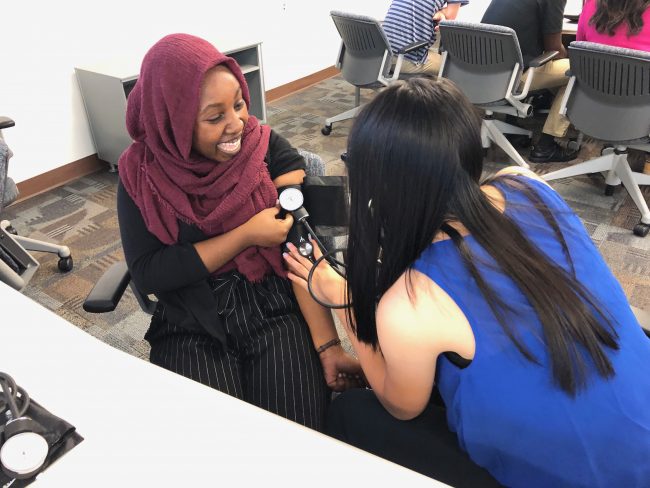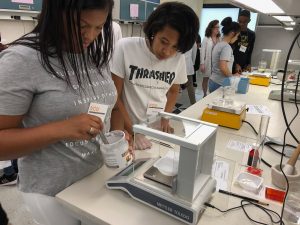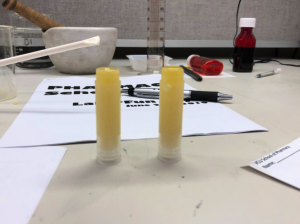High school students get a closer look at pharmacy as a career

Emiley Bagalawis
VCU School of Pharmacy News
On the tables of a gray classroom sit red buckets with hazard signs, latex gloves, cotton balls and black zippered bags. Twelve students, all teenagers, are seated at the tables. The scent of alcohol rises from opened packets as they nervously wipe their fingertips, trying to be brave.
One student takes out a meter from the black bag and inserts a small test strip. Her hand shakes as she aligns a needle with her finger, but she can not go through with it. She asks the instructor to do it for her.
“OK,” says instructor Mason Bader, a third-year pharmacy student. “On three. One —” A small snap rings out. The girl flinches, then sighs in relief. She massages her finger until a small drop of blood appears.
The students are taking part in the first year of the Pharmacy Summer Scholars program for high schoolers who are interested in a career in pharmacy. The program ran from June 17 to 21.
Most of the students are from the Richmond region; one is from California. Jasia Redmond is a rising junior from Hanover High School and heard about Pharmacy Summer Scholars through her school’s pharmacy program called The Specialty Center.
“I decided to do this because I was interested to learn more about pharmacy,” Redmond says. “It seemed interesting.”
The program is a part of VCU Pipeline Programs. Participants are charged $50 to cover food and materials, with waivers available. These programs aim to educate students on different health-science careers and diversify the health-care workforce and are offered to middle, high and college students. Middle schoolers can participate in a program offered called Pharmacy Explorers that is similar to the Pharmacy Summer Scholars.
Taryn Hayes, assistant director of recruitment and pipeline programs at VCU School of Pharmacy, is in charge of the Pharmacy Scholars program.
“I want students to have an understanding of pharmacy and the other career pathways that you can go into with a degree in pharmacy,” Hayes says. “I also want them to know about social determinants of health and why culture is important when administering care. Like how you create treatment plans based on a person’s culture. I want them to understand what culture is and how that impacts the way they treat patients.”
The five-day program features activities, discussion and lessons. Jordan Gray is a rising junior. He says one of his favorite parts of the program has been tic-tac-toe. The students play a variation of the classic game to test what they have learned so far. “It was fun,” Gray says, “it was very competitive and it opened us up to each other.”
The program also offers plenty of hands-on activities. On a recent day, in addition to a lecture about blood pressure, blood glucose

and body mass index, third-year pharmacy students Mason Bader and Nick Suarez show students how to take blood pressure and test glucose levels — the purpose of that scary needle prick.
“We take blood to measure glucose because glucose likes to stick to our red blood cells,” Bader says. “Glucose levels are measured in millimeters of glucose per liter of blood.”
Pharmacists are trained to take vital signs such as heart rate, breathing rate and body mass index in addition to blood pressure and glucose levels, the instructors explain. Suarez demonstrates how to take someone’s blood pressure using a blood pressure cuff and a stethoscope.
“After pumping up the cuff, you deflate it slowly while watching the needle fall back down,” Saurez says. “You listen for the first ‘glug,’ which is the blood rushing back in your arm, and keep a note of what number the needle passes when doing so. Then you listen for the last ‘glug’ and see what number the needle passes.”
He takes Bader’s blood pressure. The first glug is at 172, Suarez announces, the last at 72. “So his blood pressure is 117 over 72, which is normal,” Suarez says.

Another hands-on activity is led by Wylie Crane, a fourth-year pharmacy student. She gives a short lecture on compounding. Compounding is when pharmacists prepare medicines by combining or mixing ingredients.
“I call it pharmacy cooking because you take the ingredients from scratch and you make something new,” Crane says.
To get experience in compounding, the students head into a lab where they work in pairs to make lip balm—think ChapStick—out of coconut oil, cocoa butter, beeswax and a flavoring. A glass beaker is placed in a water bath to heat the ingredients after they are carefully measured. After the ingredients are melted and mixed together, the students pour the solution into molds to cool.
It’s the same process a doctor in Lynchburg, Virginia, used to invent ChapStick almost 150 years ago, and basically the same process taking place by the millions less than 20 miles away at the country’s only ChapStick factory.
The students take part in other activities such as creating a suspension of medication particles in liquid that can be taken by mouth or rubbed on skin.
And, of course, blood tests for glucose.
“Your glucose level is 105,” instructor Bader tells the student who was so anxious about pricking her finger. “Which is normal.”
The student wraps her injury with a Band-Aid. She looks pleased.
Categories Student news

